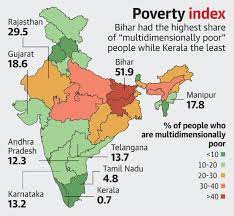The National Institution for Transforming India (NITI Aayog) is a policy think tank of the Indian government that has adopted the Multidimensional Poverty Index (MPI) to measure poverty in India. NITI Aayog has developed its own version of the MPI to suit the Indian context and provide a more accurate measure of poverty in the country.

NITI Aayog’s MPI measures poverty in India based on 10 indicators, which are grouped into three dimensions – health, education, and standard of living. The 10 indicators used by NITI Aayog include nutrition, child mortality, years of schooling, access to basic services like drinking water and sanitation, cooking fuel, and housing.
The Multidimensional Poverty Index (MPI) is a measure of poverty that takes into account multiple dimensions of poverty, including health, education, and living standards. The MPI measures poverty based on the following three dimensions:
- Health: The MPI includes indicators related to health, such as nutrition and child mortality. These indicators capture the extent to which people are deprived of basic healthcare and nutrition services.
- Education: The MPI includes indicators related to education, such as years of schooling and child enrollment in school. These indicators capture the extent to which people are deprived of basic education services.
- Standard of Living: The MPI includes indicators related to the standard of living, such as access to basic services like drinking water, sanitation, cooking fuel, and housing. These indicators capture the extent to which people are deprived of basic living standards.
Within each dimension, the MPI considers a range of indicators that are most relevant to the specific context of the country or region being measured. The indicators are chosen based on their relevance, availability, and robustness.
In addition to these dimensions, the MPI also considers the severity of poverty by taking into account the number of dimensions in which a person is deprived and the intensity of that deprivation. This allows the MPI to identify those who are most vulnerable to poverty and prioritize interventions to address their specific needs.
Overall, the MPI provides a more comprehensive picture of poverty than traditional measures, such as income or consumption, and helps policymakers to design more targeted poverty reduction policies.
The NITI Aayog MPI uses a similar methodology as the global MPI developed by OPHI and UNDP. The index measures poverty using a set of weights assigned to each indicator based on its relative importance in determining poverty. The weights are determined through a process of consultation with experts and stakeholders.
The NITI Aayog MPI provides a more comprehensive and nuanced picture of poverty in India. It identifies individuals and households that are deprived in multiple dimensions and can help policymakers to design more targeted interventions to address poverty in the country.
NITI Aayog’s MPI is regularly updated and used to track progress in poverty reduction. It is used in conjunction with other measures of poverty, such as income and consumption, to provide a more complete picture of poverty in India. By adopting the MPI, NITI Aayog has taken a significant step toward addressing poverty in India in a more comprehensive and effective manner.
Important Links